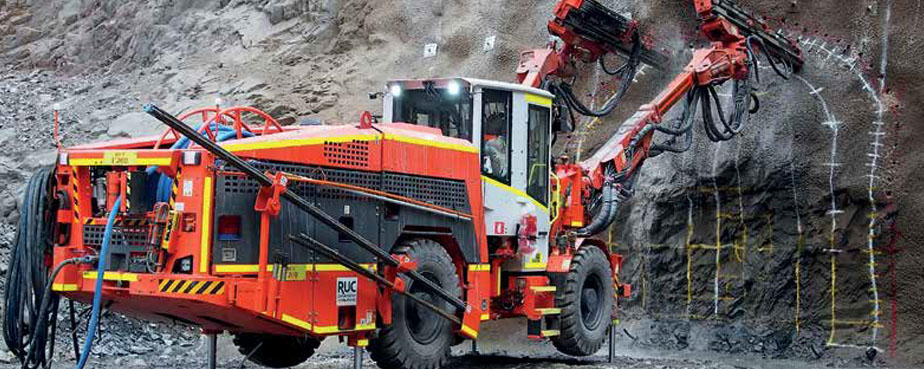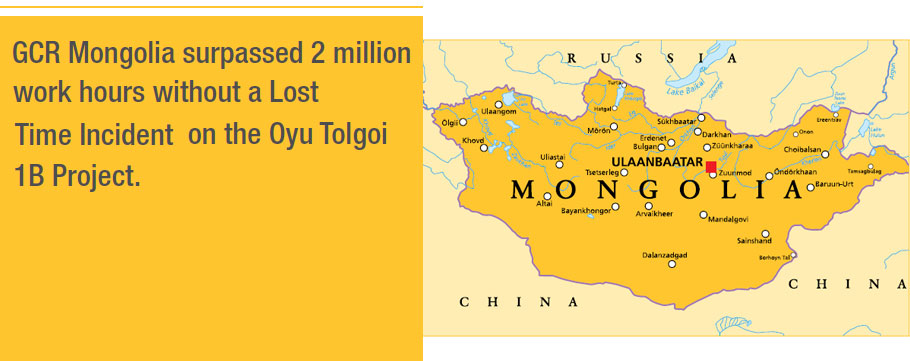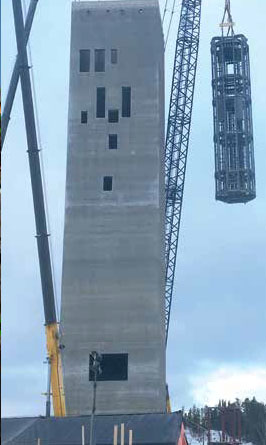BUSINESS PLATFORMS - UNDERGROUND MINING


STRONG START AT KALAGADI MANGANESE FOR MURRAY & ROBERTS CEMENTATION
Murray & Roberts Cementation, in joint venture with BCM Underground Mining, is operating ahead of schedule at the Kalagadi Manganese Mine project in the Northern Cape, South Africa.
Kalagadi Manganese Mine is situated north-west of Hotazel and has an estimated 960 million metric tonnes of manganese ore with the mine designed to produce 3 million tonnes of manganese ore at a grade between 36 and 38%. The mining method used is room and pillar.
The mine is a two-shaft system with a main man/material shaft and a separate ventilation shaft. The main shaft, with a nine metre diameter will reach a working level of 281 metres and a loading level of 317 metres. The ventilation shaft is 323 metres deep and has a seven metre diameter.
During the first 18 months of this five-year contract, Murray & Roberts Cementation will build up production to the shaft system’s nameplate capacity and thereafter operate the mine for the balance of the contract term.
As part of their commitment to transformation in the industry, Murray & Roberts Cementation will transfer skills and expertise to BCM Underground Mining, which is a 100% black-owned business. The company has also identified local SMMEs, through its Enterprise Development programme, that have the potential to deliver goods and services to the project and that they can further develop into sustainable businesses.
The project is well ahead of the contractual programme, which is attributed to the level of planning and scheduling that forms part of Murray & Roberts Cementation’s operating strategy. Says Otto Fourie, project executive at Murray & Roberts Cementation, “Another contributing factor to the project’s success is the correct deployment of skilled and competent operators which has a direct impact on production capability and the safe operation of the mine.”
The Murray & Roberts Training Academy in Carletonville, South Africa has been instrumental in developing the skills and competencies required, with all employees undergoing training before commencing work on the project.
Concludes Otto, “We have experienced and competent crews working on this project with world-class systems in place to ensure the mine’s sustainability and safe operation while delivering a quality product and service.”

GCR MONGOLIA TRAINING ACADEMY OPENS ITS DOORS
GCR Mongolia is a joint venture between Clough, RUC Cementation Mining and Gobi Infrastructure Partners and has opened a training academy in Ulaanbaatar, the capital city of Mongolia.
The joint venture is contracted to provide services to Rio Tinto on the Oyu Tolgoi mine, located in the southern Gobi desert of Mongolia, 55 kilometres south of the capital. The Oyu Tolgoi mine is one of the world’s largest known copper and gold deposits and will be a significant contributor to the development of Mongolia.
Oyu Tolgoi employee trainees will receive certified theoretical and practical training in addition to on-thejob experience equipping them with the knowledge, awareness and tools to manage the inherent risks associated with the mining and construction industry.
GCR Mongolia’s current scope of work includes construction and commissioning of the blind sink and concrete line of Shaft No 3 and No 4 as well as the construction of the Underground Material Handling System for Stage 1.
The GCR Mongolia team was recently awarded the “Best Safety Performance: Construction Contractor – Q2 October 2018” which complements the 2 million LTI-free work hours achieved.

“BIG LIFT” AT KIRKLAND LAKE GOLD’S MACASSA #4 SHAFT
The skyline of Kirkland Lake, Ontario, Canada, changed when the 65 metre tall concrete headframe for Kirkland Lake Gold’s new Macassa #4 shaft was slip formed in just 10 days. This was followed by another significant event in the #4 shaft construction when the team of Cementation, Tesc, Anmar, Northern Equipment, Niiwin GP, Shaba Testing, Peter Bull, MDB Mining and Kirkland Lake Gold carried out the “big lift” – the lift and placement of the shaft sinking Galloway and the equipping deck into the shaft collar through the top of the headframe.
The lift started on Friday, 16 November, with a single drop deck that would be later attached to the bottom of the main Galloway. The big lift occurred the next day. The Galloway, over 91 tonnes and 26 metres long, had to be lifted over the top of the 65 metre high headframe and lowered into an exact position below surface in the shaft collar. The crane cables were extended 127 metres from the tip of the boom to the final position of the Galloway where the steel work platform was secured to the concrete walls of the shaft. A Liebherr 750 tonne crane was used to carry out the lift. Custom designed rigging was fabricated to ensure evenly distributed weight and a plumb (vertical) load for all three lifts. The lift commenced at 15:00 on Saturday and by 19:30 the Galloway had been secured in the shaft, weight had been transferred, and as Tom Wadey, Area Manager with Cementation Canada put it, “The Eagle had landed.”
The scale and uniqueness of the job was such that when the lift was explained to a veteran crane operator, with over 40 years of experience, he exclaimed, “This one should make the cover of Crane Monthly!”
The lift of the equipping deck, a 41 tonne work stage was postponed on Sunday due to windy conditions. By 09:15 on Monday, the equipping deck was in the shaft and secured to the cantilevered beams that support it.
The success of the big lift is testament to the tremendous amount of planning that went into ensuring the safety of all employees.
Cementation Canada was awarded the design and construction of the #4 shaft at Kirkland Lake Gold’s Macassa Mine in 2018. The Macassa Mine is a high-grade gold mine which has been a prolific producer since 1933. This new shaft will offer a number of important benefits to the mine. Construction of the 6.6 metre diameter, concrete-lined shaft will be carried out in two phases. Completion of phase one is targeted for 2022 to a depth of 1 661 metres.

